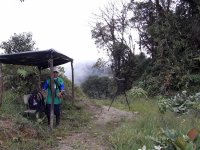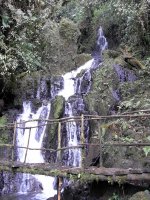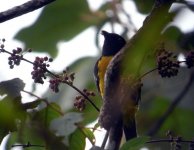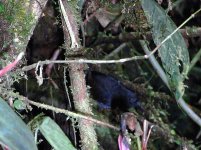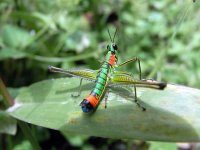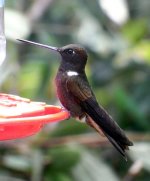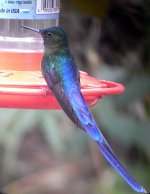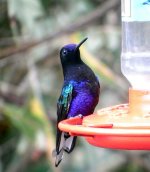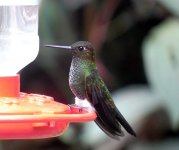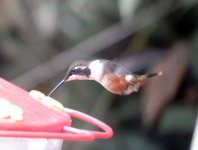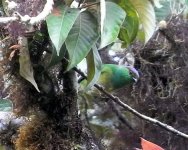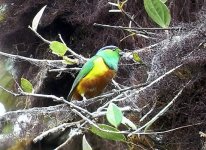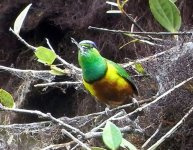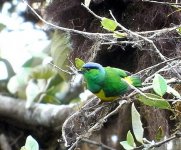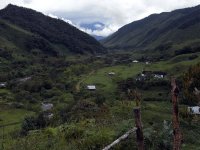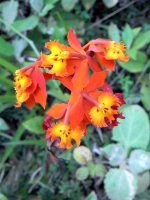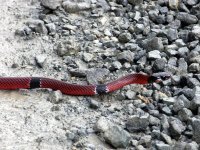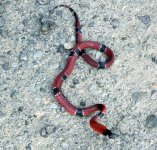antshrike69
Well-known member

11/10/10 - Las Tangaras
I left El Carmen in time to be at Las Tangaras for first light, collecting the forest guard Huvernay en route and seeing Band-winged Nightjars on the road. The reserve is not far from the town, set in steep forest full of western Andean specialities including lots of the Chocó endemics restriced to western Colombia, some reaching into NW Ecuador. There are several main targets here, but a big supporting cast and I had allocated the second 'spare day' to increase my chances of connecting with some of them.
Before Trevor had left for Bogotá, he had given me detailed gen for the site and this was to prove very useful indeed. We parked on the road below the reserve, and had breakfast accompanied by the first mixed flock of the day with Red-headed Barbet, Capped Conebill and various tanagers. In a tree above the car were 6 Toucan Barbets - today was going to be good!
Well what can I say? Las Tanagaras rocks. The day was packed with birds with some of the bext mixed flocks I have ever seen and Chocó endemics everywhere. I could have spent a week here.
A trail starts at the roadside, heading up through pasture to the forest proper. A huge solitary tree is a regular site for White-headed Wren and the briefest blast of tape produced 9 of these huge wrens, churring and chattering as they probed the epiphytes for food.
Trevor had suggested a plan of action - get to the ridge quickly as this is the only real chance for Gold-ringed Tanager which moves off to feeding areas early in the day. Score this one and then work your way back down. Having seen GRT in Colombia before, I was too easily diverted by the sheer number of goodies and very quickly decided that GRT (nice a bird as it is) would not be featuring on the day's menu.
Only 10 minutes or so into the forest, the variety of calls ahead signalled a mixed flock. The steep slope meant we were suddenly surrounded by a commotion of birds as it became quickly apparent this wasn't any old mixed flock. One of the first in the bins was a Black and Gold Tanager - a major target. This rather stolid chunky tanager was feeding on fruits in the subcanopy and was one of the birds I most wanted here. As it turned out, Trevor was right: they are common at Las Tangaras and most mixed flocks contained a few of these endemics. The second bird was a Fulvous-dotted Treerunner, a Chocó speciality, and as I followed it up the branch it was working, it crossed paths with two Pacific Tuftedcheeks! Higher up were Glistening-Green Tanagers, Black-chinned Mountain-Tanagers , a male Barred Becard and Uniform Treehunter, as well as swirls of Tangara tanagers and tyrannulets. We followed the flock for some time until I was rudely diverted by the song of the very local Chocó Vireo from the edge of the flock further up the trail. Sadly, the bird slipped away but given that this species is apparently seasonal here, this was a good sign.
Tearing ourselves away from this exuberant mass of birds, we headed upwards. Trevor had told me about a territory for the recently-discovered Alto Pisones Tapaculo. I hadn't heard a single tapaculo since we arrived and I settled down expecting a long wait. One phrase from the i-Pod and from the corner of my eye, a small grey shape scuttled through a gap in the undergrowth and dropped from a fallen branch to the leaf litter. I waited. The shape moved right, almost completely concealed by ferns. I decided against further tape and stayed put. Amazingly, the small grey shape jumped up onto a low twig, revealing itself as an Alto Pisones Tapaculo, before scampering up a vertical sapling to a height of 4 metres or so. Bizarre. It looked down at me, then launched itself into the air in what it no doubt considered an elegant proof of birds' mastery of the air and glided across the trail. The fact that it lost 2 metres altitude in less horizontal distance suggested it had not done this many times before: tapaculos are hardly built for flight. Landing behind me, it burst into song confirming the identification. This species was only discovered in 1992 by Gary Stiles and is still only known from a tiny handful of localities. The song is distinctive - a series of harsh rolling churrs - and I heard it several more times during the day. Nariño Tapaculo is also common at Las Tangaras so, as always with these birds, a singing individual is vital to confirm ID. The APT made ten tapaculos so far - gotta love these tiny secretive birds.
As the tapaculo continued to sing, a Yellow-breasted Antpitta sang its clear whistle from a short distance ahead. Inching up the trail, I glimpsed the culprit a few feet away but it melted away. After a lengthy spell of cat-and-mouse it was Huvernay who found the bird singing in a mossy wet tangle just off the trail. It gave stellar views as it sang, throat pulsing and tail flicking. Very nice. Less expected was a Sharp-tailed Streamcreeper on wet rocks nearby - although relatively common in SE Brazil, this was my first in the Andes. Olive Finch sang from the same gulley although proved very uncooperative, and a Fulvous-breasted Flatbill showed well.
We returned to the car for lunch adding Bronze-olive Pygmy-Tyrant, Black Solitaire, Olivaceous Piha, the outrageously-beautiful Purplish-mantled Tanager and others. A party of Sharpe's Wrens got my pulse racing as these often travel with Crested Ant-Tanager, another major target. I had trawled for these at all the usual spots with no success, even though one birder had mentioned having to virtually fight them off in order to see other birds! They like streams, waterfalls and wet gulleys and are very vocal but the i-Pod had produced no results and the wrens were alone today.
Huvernay knew a few sites for the Ant-Tanager lower down the road, and so began an afternoon of staring at tanagerless streams and cascades. We did find Red-bellied Grackles (new for the trip) moving with a party of Russet-backed Oropendolas. These charismatic birds fed just off the road and were much appreciated - real favourites of mine. White-naped Brush-Finch was also new for the trip as was Flame-rumped Tanager. The road dropped in altitude from the reserve and we started to see some birds of lower elevations such as beautiful Silver-throated and Rufous-throated Tanagers in the Cecropias along the forest edge.
Admitting defeat, we spent the last hour of daylight at the hummingbird feeders by the reserve entrance clocking up Velvet-Purple Coronet, Violet-tailed Sylph, Brown and Collared Inca, Greenish Puffleg and Fawn-breasted and Empress Brilliants.
So ended what had been an awesome day of birding and I headed back to El Carmen knowing I had another full day tomorrow at this incredible site.
I left El Carmen in time to be at Las Tangaras for first light, collecting the forest guard Huvernay en route and seeing Band-winged Nightjars on the road. The reserve is not far from the town, set in steep forest full of western Andean specialities including lots of the Chocó endemics restriced to western Colombia, some reaching into NW Ecuador. There are several main targets here, but a big supporting cast and I had allocated the second 'spare day' to increase my chances of connecting with some of them.
Before Trevor had left for Bogotá, he had given me detailed gen for the site and this was to prove very useful indeed. We parked on the road below the reserve, and had breakfast accompanied by the first mixed flock of the day with Red-headed Barbet, Capped Conebill and various tanagers. In a tree above the car were 6 Toucan Barbets - today was going to be good!
Well what can I say? Las Tanagaras rocks. The day was packed with birds with some of the bext mixed flocks I have ever seen and Chocó endemics everywhere. I could have spent a week here.
A trail starts at the roadside, heading up through pasture to the forest proper. A huge solitary tree is a regular site for White-headed Wren and the briefest blast of tape produced 9 of these huge wrens, churring and chattering as they probed the epiphytes for food.
Trevor had suggested a plan of action - get to the ridge quickly as this is the only real chance for Gold-ringed Tanager which moves off to feeding areas early in the day. Score this one and then work your way back down. Having seen GRT in Colombia before, I was too easily diverted by the sheer number of goodies and very quickly decided that GRT (nice a bird as it is) would not be featuring on the day's menu.
Only 10 minutes or so into the forest, the variety of calls ahead signalled a mixed flock. The steep slope meant we were suddenly surrounded by a commotion of birds as it became quickly apparent this wasn't any old mixed flock. One of the first in the bins was a Black and Gold Tanager - a major target. This rather stolid chunky tanager was feeding on fruits in the subcanopy and was one of the birds I most wanted here. As it turned out, Trevor was right: they are common at Las Tangaras and most mixed flocks contained a few of these endemics. The second bird was a Fulvous-dotted Treerunner, a Chocó speciality, and as I followed it up the branch it was working, it crossed paths with two Pacific Tuftedcheeks! Higher up were Glistening-Green Tanagers, Black-chinned Mountain-Tanagers , a male Barred Becard and Uniform Treehunter, as well as swirls of Tangara tanagers and tyrannulets. We followed the flock for some time until I was rudely diverted by the song of the very local Chocó Vireo from the edge of the flock further up the trail. Sadly, the bird slipped away but given that this species is apparently seasonal here, this was a good sign.
Tearing ourselves away from this exuberant mass of birds, we headed upwards. Trevor had told me about a territory for the recently-discovered Alto Pisones Tapaculo. I hadn't heard a single tapaculo since we arrived and I settled down expecting a long wait. One phrase from the i-Pod and from the corner of my eye, a small grey shape scuttled through a gap in the undergrowth and dropped from a fallen branch to the leaf litter. I waited. The shape moved right, almost completely concealed by ferns. I decided against further tape and stayed put. Amazingly, the small grey shape jumped up onto a low twig, revealing itself as an Alto Pisones Tapaculo, before scampering up a vertical sapling to a height of 4 metres or so. Bizarre. It looked down at me, then launched itself into the air in what it no doubt considered an elegant proof of birds' mastery of the air and glided across the trail. The fact that it lost 2 metres altitude in less horizontal distance suggested it had not done this many times before: tapaculos are hardly built for flight. Landing behind me, it burst into song confirming the identification. This species was only discovered in 1992 by Gary Stiles and is still only known from a tiny handful of localities. The song is distinctive - a series of harsh rolling churrs - and I heard it several more times during the day. Nariño Tapaculo is also common at Las Tangaras so, as always with these birds, a singing individual is vital to confirm ID. The APT made ten tapaculos so far - gotta love these tiny secretive birds.
As the tapaculo continued to sing, a Yellow-breasted Antpitta sang its clear whistle from a short distance ahead. Inching up the trail, I glimpsed the culprit a few feet away but it melted away. After a lengthy spell of cat-and-mouse it was Huvernay who found the bird singing in a mossy wet tangle just off the trail. It gave stellar views as it sang, throat pulsing and tail flicking. Very nice. Less expected was a Sharp-tailed Streamcreeper on wet rocks nearby - although relatively common in SE Brazil, this was my first in the Andes. Olive Finch sang from the same gulley although proved very uncooperative, and a Fulvous-breasted Flatbill showed well.
We returned to the car for lunch adding Bronze-olive Pygmy-Tyrant, Black Solitaire, Olivaceous Piha, the outrageously-beautiful Purplish-mantled Tanager and others. A party of Sharpe's Wrens got my pulse racing as these often travel with Crested Ant-Tanager, another major target. I had trawled for these at all the usual spots with no success, even though one birder had mentioned having to virtually fight them off in order to see other birds! They like streams, waterfalls and wet gulleys and are very vocal but the i-Pod had produced no results and the wrens were alone today.
Huvernay knew a few sites for the Ant-Tanager lower down the road, and so began an afternoon of staring at tanagerless streams and cascades. We did find Red-bellied Grackles (new for the trip) moving with a party of Russet-backed Oropendolas. These charismatic birds fed just off the road and were much appreciated - real favourites of mine. White-naped Brush-Finch was also new for the trip as was Flame-rumped Tanager. The road dropped in altitude from the reserve and we started to see some birds of lower elevations such as beautiful Silver-throated and Rufous-throated Tanagers in the Cecropias along the forest edge.
Admitting defeat, we spent the last hour of daylight at the hummingbird feeders by the reserve entrance clocking up Velvet-Purple Coronet, Violet-tailed Sylph, Brown and Collared Inca, Greenish Puffleg and Fawn-breasted and Empress Brilliants.
So ended what had been an awesome day of birding and I headed back to El Carmen knowing I had another full day tomorrow at this incredible site.
Last edited:





